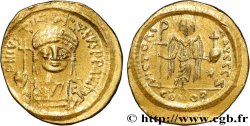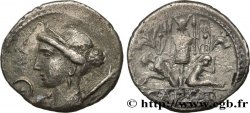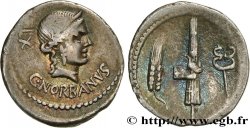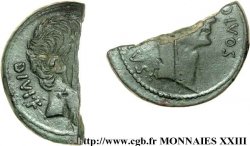v23_0332 - OCTAVE ET JULES CÉSAR Sesterce ou dupondius, coupé en deux (GB, Æ 31)
MONNAIES 23 (2004)
Startpreis : 150.00 €
Schätzung : 250.00 €
Erzielter Preis : 150.00 €
Startpreis : 150.00 €
Schätzung : 250.00 €
Erzielter Preis : 150.00 €
Type : Sesterce ou dupondius, coupé en deux (GB, Æ 31)
Datum: 38 AC.
Name der Münzstätte / Stadt : Rome ou Italie
Metall : Bronze
Durchmesser : 31 mm
Stempelstellung : 10 h.
Gewicht : 11,41 g.
Seltenheitsgrad : R1
Kommentare zum Erhaltungszustand:
Jolie patine verte. Témoignage intéressant
N° im Nachschlagewerk :
B.101 - RPC.621 - BMC/RR.108 - CRR.309 - RCV.1570 (1040$) - CRI.309 - C.95 - MRR.1685 (600€) - RRC.535 /2
Vorderseite
Titulatur der Vorderseite [CAESAR] -DIVI. F..
Beschreibung Vorderseite (Têtes nue d’Otave à droite).
Übersetzung der Vorderseite “Caesar Divi Filius”, (César le divin fils).
Rückseite
Titulatur der Rückseite DIVOS/ [IVL]IVS.
Beschreibung Rückseite (Tête laurée de César à droite).
Übersetzung der Rückseite “Divos/Iulios”, (du divin Jules).
Kommentare
Pour cette série, les auteurs du RPC ont répertorié 62 pièces avec vingt-et-un coins de droit. Ce type de monnaie se rencontre rarement coupé ; le fait qu’il y ait deux têtes, une de chaque côté, en est peut-être la cause. En revanche, en Gaule nous avons de nombreux exemples de pièces de Vienne, Lyon, Orange ou Nîmes qui sont coupées, mais les deux bustes sont toujours au droit.
For this series, the authors of the RPC listed 62 coins with twenty-one obverse dies. This type of coin is rarely found cut; the fact that there are two heads, one on each side, is perhaps the reason. On the other hand, in Gaul we have numerous examples of coins from Vienna, Lyon, Orange or Nîmes which are cut, but the two busts are always on the obverse
For this series, the authors of the RPC listed 62 coins with twenty-one obverse dies. This type of coin is rarely found cut; the fact that there are two heads, one on each side, is perhaps the reason. On the other hand, in Gaul we have numerous examples of coins from Vienna, Lyon, Orange or Nîmes which are cut, but the two busts are always on the obverse








 Berichten über einen Fehler
Berichten über einen Fehler Die Seite drucken
Die Seite drucken Teilen meiner Auswahl
Teilen meiner Auswahl Stellen Sie eine Frage
Stellen Sie eine Frage Einlieferung/Verkauf
Einlieferung/Verkauf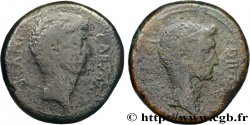
 Details
Details
